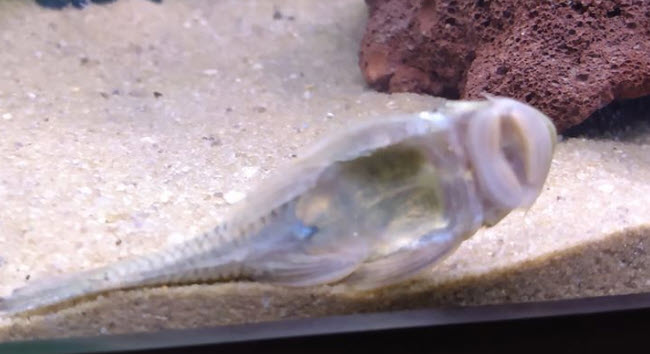
If most of the fish in an aquarium have “hollow belly” this is generally due to lack of enough food. If only a few fish have a “hollow belly” the number of possible pathogens is in the hundreds.
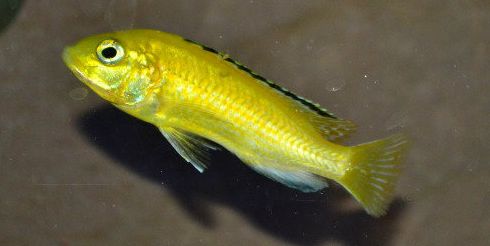
Causes of “Hollow Belly”:
Fish get “hollow belly” because some pathogen is interfering in the normal absorption of nutrients. Necropsies on dead fish with “hollow belly” show the following incidence:
- 40% have fish TB (treat with over-filtration and UV)
- 15% have “hexamita” (treat with metronidazole)
- 10% have bacterial infections (treat with antibiotics)
- 5% have roundworms (treat with Fenbendazole)
- 30% have no clear cause
The biggest cause of “hollow belly” in a well-fed aquarium is fish TB (which scientists call Environmental Mycobacteriosis or “EM”), a persistent and extremely common bacteria found naturally in most tanks. It goes by the name”wasting disease”. There are no medicines for fish TB. Here are some articles on fish tuberculosis:
10.4. Fish Tuberculosis
10.4.1. Fish Tuberculosis in Depth
.
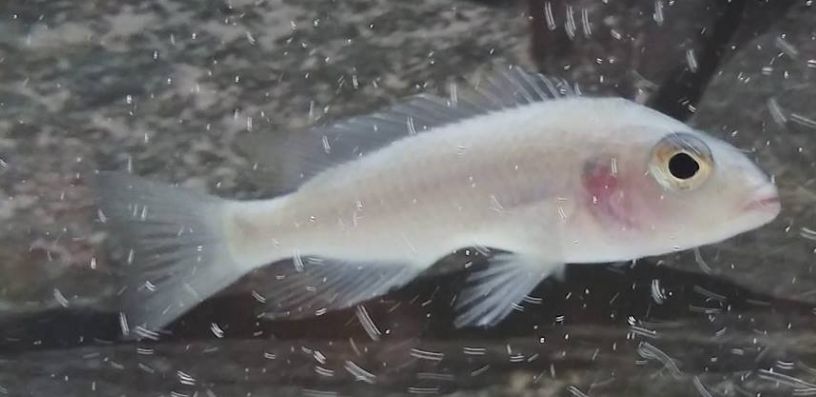
Treating “Hollow Belly”
“Hollow belly” in a well-fed aquarium should be treated by add large amounts of biofiltration and a UV unit to the aquarium if one doesn’t already have that. These actions reduce the bacterial count in the water which in turn reduces the load on the immune system of the fish. The immune system is thus better able to attack whatever is affecting the fish. Most of the time hollow belly with no associated symptoms is fish TB (environmental mycobacteriosis). Fish TB can be reversed with lots of biofiltration and very clean bacteria free water.
If the fish only has hollow belly as a symptom, clean, bacteria free water is the ONLY treatment which should be given. But sometimes there are other symptoms which show up that indicate an intestinal infection:
- Stringy white poop
- Not eating
- Food spitting
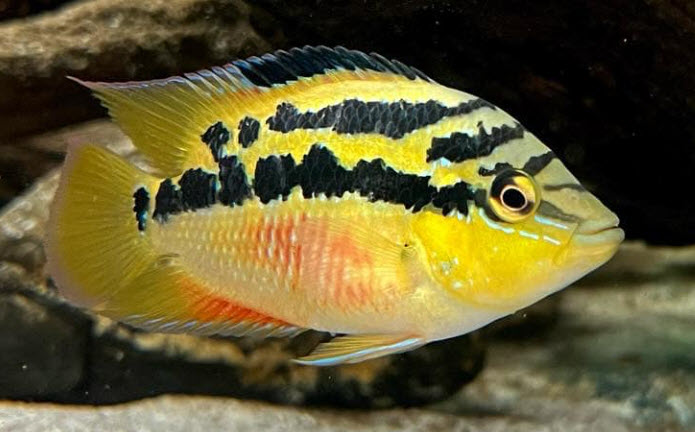
If one of these symptoms shows up in combination with hollow belly the probabilities change with regard to the cause of the hollow belly. Necropsies on dead fish with hollow belly combined with any of the above three symptoms show the following incidence:
- 40% have “hexamita” (treat with metronidazole and Epsom salts)
- 30% have capillaria (treat with Fenbendazole or Levamisole)
- 20% have bacterial infections (treat with antibiotic)
- 10% have no apparent pathogen
It is best to isolate the fish in a bare bottom hospital tank and add medicated food. First buy SeaChem MetroPlex, Maracyn 2, and Fenbendazole or Levamisole(or the optional medication listed below) over the internet.
Heat 1/4 cup water (two ounces or 58 milliliters, not a lot) in the microwave. Then blend seven grams of plain animal derived gelatin (Knox gelatin, one packet) into the hot solution with vigorous stirring. Take two tablespoons of dry commercial fish food (pellets or flake) and mix it with just a little of the hot water/ gelatin mixture. Add hot water/gelatin until you get a paste like consistency. If it gets too watery just add more food.
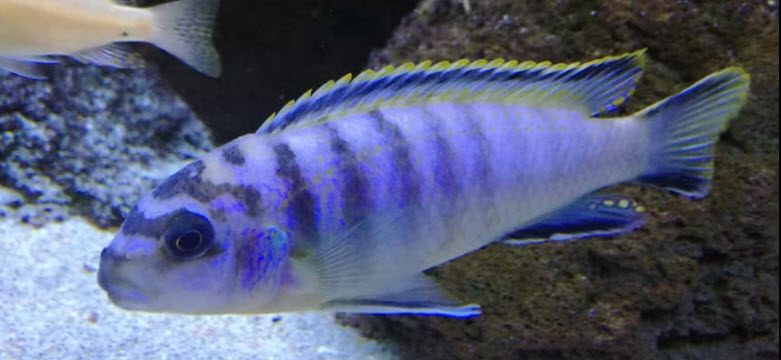
Then add just a “smidgen” (roughly 1/16 teaspoon, a 1% to 2% addition) of medication to the mud. If you are using more than one medication mix the medications together, then use just a “smidgen” of the mixture. If you are using a packet of medication, take just a “smidgen” of the packet contents. Mix and mash the whole mass thoroughly. Spread it out into a pancake about 1/8th inch (3 mm) thick on a plastic film or a plate. Then put in the refrigerator. If you plan on keeping it for more than two weeks put it in a small plastic bag and freeze.
Make up two portions of this medication. One for the Maracyn 2 and the Metroplex and one for the Fenbendazole or Levamisole. Feed the Maracyn 2/Metroplex for ten days as a steady diet. Feed the Fenbendazole or Levamisole every two weeks for three months.
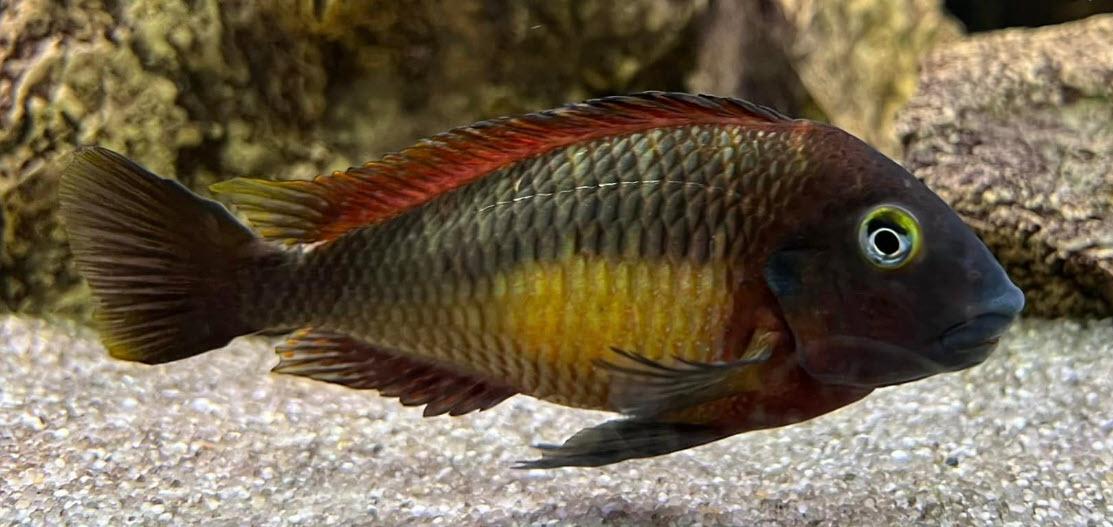
The treatment for “hollow belly” has some options:
- Fenbendazole is available as Safeguard for dogs or several livestock dewormers. An alternative medication is Levamisole which is available on Amazon, subaquaria .com and Valleyvet .com. Levamisole can also be purchased as Agrilabs Prohibit Soluble Drench Powder and Durvet Levamed Soluble Drench Powder Dewormer. Other medications supposedly effective against roundworms are Pyrantel Pamoate, Flubendazole (Kusuri Wormer Plus) and Piperazine.
- Broad spectrum antibiotics available in the US include Midland Vet Service Aqua-Mox, SeaChem KanaPlex, VetDepot Amoxicillin, Fishbiotic Ampicillin, Mardel Maracyn 2.
- Metronidazole, alias metro’ is available in SeaChem MetroPlex and can be simply mixed into the food. Or it can come in premixed food medication such as Hikari Metro Plus food or New Life Spectrum Hex-Shield food.
Also note the directions with most aquarium medications tell one to put large amounts of the medication into the aquarium’s water. This is a huge scam perpetuated by suppliers of aquarium medications. Fish don’t drink! And they also don’t absorb medications through their skin or gills. This controversial topic is covered in this link:
12.5. Fish Don’t Drink
Also note than when presented with hollow belly many people start feeding their fish more. Starvation is rarely the cause of hollow belly, especially if the symptoms are in only a few fish. Of course if all fish have hollow belly look hard at the amount of food. But if one is feeding an amount of food equal to two eyeballs in volume (six fish = twelve eyeballs) once a day added feeding may only make the problem worse.
Do not feed more than the fish can consume in one minute once per day.
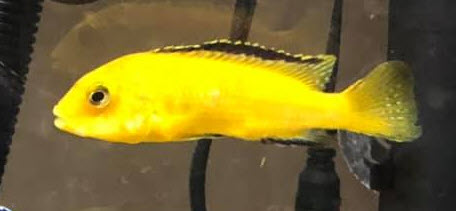
Here is an article on how to calculate how much to feed:
3.3. How much to Feed Fish
The symptom of hollow belly is often accompanied by another symptom. These symptoms are covered separately in these articles:
11.2. White Poop
11.15. Fish not eating
.
Return to Symptoms Menu
.
Aquarium Science Website
The chapters shown below or on the right side in maroon lead to close to 400 articles on all aspects of keeping a freshwater aquarium. These articles have NO links to profit making sites and are thus unbiased in their recommendations, unlike all the for-profit sites you will find with Google. Bookmark and browse!
.

Rebecca Seeley says
Thank you very much!!!
Dave says
In reply to Rebecca …. Use the directions for fish not eating.
Rebecca Seeley says
If I have some hollow belly and some not eating going on what would be the best course of treatment? I have both Lev and Fenben and am interested in using both to cover the most ground, so to speak. There are different directions on each disease as to how often to feed, which meds to feed, etc. Thank you so much!!
Joshua says
@Dave – I haven’t had that issue so I’ll keep up with it for now since I only have a few days left per the Seachem instructions. I’ve used gelatin foods in the past so I’ll just go back to that unless this actually works.
Dave says
In reply to Joshua … Mixing the medication into pelleted food didn’t work out very well for me. The redried pellets just turned to powder when they hit the water.
Joshua Austin says
I see in mostly all (maybe all because I have only read about 60% of your pages on various diseases) that you mention using gelatin style food when mixing medications with food. What are you thoughts about using pellets? I believe the Seachem Metroplex gives directions for this but they recommend using Seachem Focus as a binder. I am currently fighting one fish with a minor case of Hollow Belly and another with a more sever case and I am using this method as recommended by the directions from Seachem (feed daily up to three weeks). I in the middle of the third week and it seems to be working but it is difficult to tell for sure. If that doesn’t work I plan to use some Levamisole I picked up from Subaquaria or some Kanaplex I have on hand next.